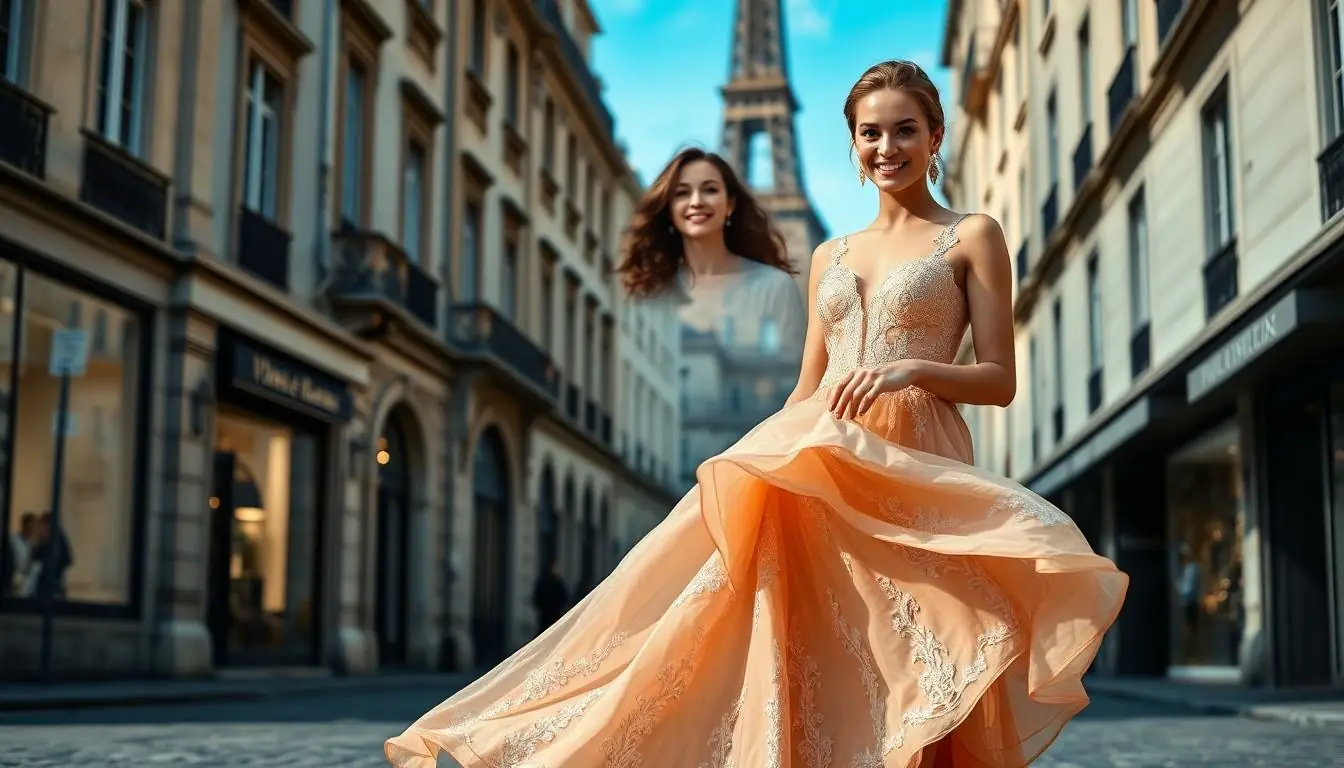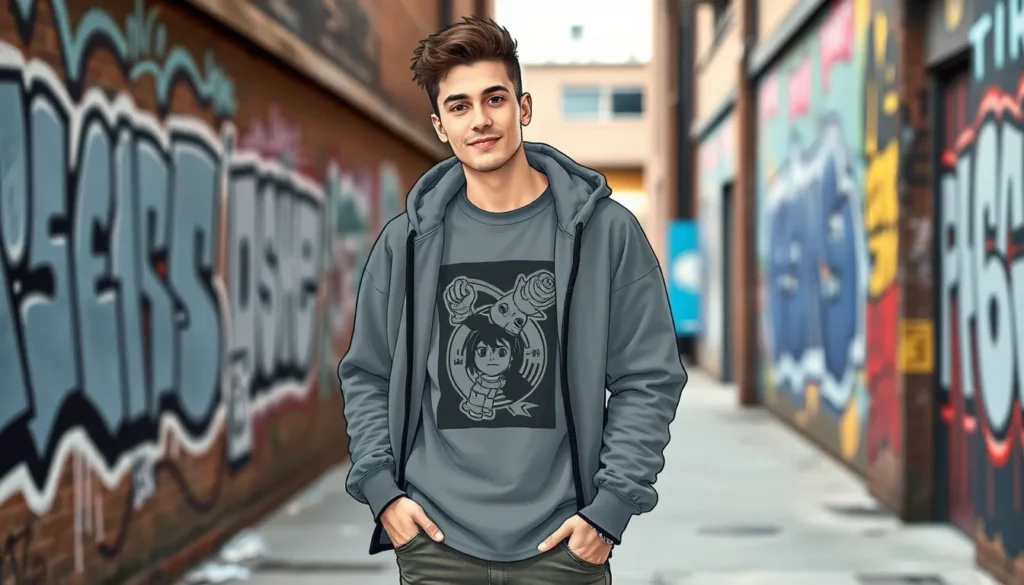Fashion lovers often find themselves tangled in the glamorous web of couture and haute couture. While both styles promise elegance and sophistication, they’re not quite the same. Imagine couture as that chic friend who always looks fabulous at brunch, while haute couture is the high-maintenance diva who requires a personal stylist and an entourage just to grab coffee.
Understanding the difference can elevate anyone’s fashion game from basic to breathtaking. Couture offers ready-to-wear luxury, perfect for those who want to strut their stuff without the wait. Haute couture, on the other hand, is the pinnacle of fashion artistry, crafted with precision and exclusivity. Dive into this stylish showdown to discover which term deserves a spot in your wardrobe and why it matters more than you think.
Table of Contents
ToggleDefinition of Couture
Couture refers to fashionable clothing created specifically for individual clients, emphasizing luxurious materials and tailored fits. This segment of the fashion industry encompasses a wide range of styles and offers both ready-to-wear and custom pieces.
Historical Context
Couture’s origins trace back to the 19th century, primarily in Paris, where designers like Charles Frederick Worth revolutionized fashion with personalized creations. By the 1940s, couture solidified its place in high fashion, blending artistry with individual expression. This evolution transformed how clothing represented social status and personal identity, making couture a significant element of culture.
Key Characteristics
Couture emphasizes craftsmanship and quality, often marked by intricate detailing and innovative techniques. It involves custom designs tailored to specific measurements and preferences, ensuring a perfect fit for each client. Textiles used in couture are typically luxurious, from silks to fine wools, enhancing the garment’s overall appeal. Couture pieces often reflect the designer’s artistic vision, setting trends in the broader fashion landscape.
Understanding Haute Couture

Haute couture represents the epitome of luxury fashion, characterized by meticulous craftsmanship and exclusivity.
Origins and Development
Haute couture traces its roots back to mid-19th century Paris. Charles Frederick Worth, often recognized as the father of haute couture, pioneered the concept of custom-fitted clothing for wealthy clients. Designers began creating unique garments to reflect individual styles, elevating fashion to an art form. These tailored creations rapidly gained popularity among the elite, shaping the fashion industry. Historical milestones, such as the establishment of the Chambre Syndicale de la Haute Couture in 1868, further formalized the standards and practices of haute couture. By the 1940s, haute couture had solidified its status as a powerful symbol of sophistication and prestige, continuing to evolve with changing societal trends while maintaining its core principles of artistry and personal expression.
Regulatory Standards
Regulatory standards govern haute couture, ensuring it maintains its exclusivity and high-quality craftsmanship. Established by the Chambre Syndicale de la Haute Couture, specific criteria dictate what qualifies as haute couture. Designers must create made-to-order garments for private clients, employing substantial handwork and engaging in significant creative processes. Additionally, each piece requires fitting sessions, ultimately tailored for individual body shapes. These stringent standards protect the integrity of haute couture while distinguishing it from ready-to-wear collections. Compliance with these regulations affirms a brand’s commitment to haute couture, reinforcing its dedication to excellence and artistry.
Couture vs Haute Couture: Key Differences
Couture and haute couture distinguish themselves through their design philosophies and production processes.
Design and Craftsmanship
Couture focuses on creating garments tailored to individual clients with a strong emphasis on luxurious materials. Each piece reflects exceptional craftsmanship, with intricate detailing and innovative techniques that elevate everyday attire. Haute couture emphasizes artistry and exclusive designs crafted with the utmost precision. Made-to-order pieces showcase extensive handwork, ensuring that each item is a unique manifestation of creative vision. The craftsmanship in haute couture exemplifies a commitment to pushing the boundaries of fashion.
Target Audience and Market
Couture targets fashion-forward individuals who appreciate luxury and personalization in their wardrobes. Clients often seek chic styles that fit their personal aesthetic while making a statement. Haute couture caters primarily to elite clientele, including celebrities and affluent buyers, who desire one-of-a-kind masterpieces. This segment values exclusivity and the symbolic representation of wealth and status inherent in haute couture garments.
Pricing and Exclusivity
Couture prices reflect the high-quality materials and tailored craftsmanship, but they remain accessible compared to haute couture offerings. Customers invest in pieces that combine luxury with practicality, often purchasing them for special occasions. Haute couture, however, commands extraordinary prices due to its exclusivity and labor-intensive production methods. Clients often pay top dollar for bespoke creations, making haute couture a pinnacle of luxury fashion that remains largely unattainable for the average consumer.
The Impact of Couture and Haute Couture on Fashion
Couture and haute couture significantly influence the fashion landscape today. Their contrasting characteristics shape trends and cultural expressions, making them vital in understanding contemporary fashion dynamics.
Influences on Trends
Couture often leads fashion trends with unique designs and innovative techniques. Designers craft pieces that showcase artistic vision, setting the stage for what’s next in mainstream fashion. Haute couture, on the other hand, sets unattainable standards through extravagant artistry and craftsmanship. Designers like Dior and Chanel create iconic pieces that inspire seasonal collections across various brands. This interplay between couture and haute couture drives designers to push creative boundaries, ultimately shaping consumer preferences and expectations.
Cultural Significance
Couture and haute couture reflect societal values and cultural motifs. They serve as a visual representation of luxury and status, often influencing personal identity. Couture’s personalized nature allows individuals to express themselves uniquely, enhancing their social standing. Haute couture carries deeper prestige, often associated with celebrity culture and high-profile events. Designers release collections that resonate with historical and cultural narratives, ensuring their relevance in today’s society. These fashion forms navigate cultural conversations, affirming their place as powerful mediums for artistic expression and societal commentary.
Conclusion
Couture and haute couture each play a unique role in the fashion industry. While couture offers personalized luxury and craftsmanship for fashion enthusiasts, haute couture represents the pinnacle of artistic expression and exclusivity. Understanding these distinctions enriches one’s appreciation for fashion and highlights the artistry behind each garment.
As fashion continues to evolve, both couture and haute couture will remain influential, inspiring trends and setting standards. They reflect not just personal style but also cultural narratives, making them essential components of the fashion dialogue. Embracing these concepts allows individuals to navigate the world of fashion with confidence and insight.








